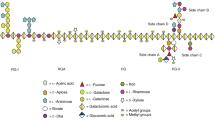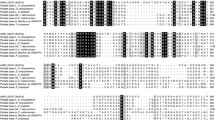Abstract
Compared to other plant cell wall-degrading enzymes, proteases are less well understood. In this study, the extracellular metalloprotease Prt1 from Pectobacterium carotovorum (formerly Erwinia carotovora) was expressed in Escherichia coli and characterized with respect to N-terminal processing, thermal stability, substrate targets, and cleavage patterns. Prt1 is an autoprocessing protease with an N-terminal signal pre-peptide and a pro-peptide which has to be removed in order to activate the protease. The sequential cleavage of the N-terminus was confirmed by mass spectrometry (MS) fingerprinting and N-terminus analysis. The optimal reaction conditions for the activity of Prt1 on azocasein were at pH 6.0, 50 °C. At these reaction conditions, K M was 1.81 mg/mL and k cat was 1.82 × 107 U M−1. The enzyme was relatively stable at 50 °C with a half-life of 20 min. Ethylenediaminetetraacetic acid (EDTA) treatment abolished activity; Zn2+ addition caused regain of the activity, but Zn2+addition decreased the thermal stability of the Prt1 enzyme presumably as a result of increased proteolytic autolysis. In addition to casein, the enzyme catalyzed degradation of collagen, potato lectin, and plant extensin. Analysis of the cleavage pattern of different substrates after treatment with Prt1 indicated that the protease had a substrate cleavage preference for proline in substrate residue position P1 followed by a hydrophobic residue in residue position P1′ at the cleavage point. The activity of Prt1 against plant cell wall structural proteins suggests that this enzyme might become an important new addition to the toolbox of cell-wall-degrading enzymes for biomass processing.








Similar content being viewed by others
References
Alexander PA, Ruan B, Bryan PN (2001) Cation-dependent stability of subtilisin. Biogeosciences 40:10634–10639
Bauer S, Vasu P, Persson S, Mort AJ, Somerville CR (2006) Development and application of a suite of polysaccharide-degrading enzymes for analyzing plant cell walls. Proc Natl Acad Sci U S A 103:11417–11422
Beg QK, Kapoor M, Mahajan L, Hoondal GS (2001) Microbial xylanases and their industrial applications: a review. Appl Microbiol Biotechnol 56:326–338
Bell KS, Sebaihia M, Pritchard L, Holden MTG, Hyman LJ, Holeva MC, Thomson NR, Bentley SD, Churcher LJC, Mungall K, Atkin R, Bason N, Brooks K, Chillingworth T, Clark K, Doggett J, Fraser A, Hance Z, Hauser H, Jagels K, Moule S, Norbertczak H, Ormond D, Price C, Quail MA, Sanders M, Walker D, Whitehead S, Salmond GPC, Birch PRJ, Parkhill J, Toth IK (2004) Genome sequence of the enterobacterial phytopathogen Erwinia carotovora subsp. atroseptica and characterization of virulence factors. Proc Natl Acad Sci U S A 101(30):11105–11110
Bhat MK (2000) Cellulases and related enzymes in biotechnology. Biotechnol Adv 18:355–383
Brinckmann J (2005) Collagens at a glance. Top Curr Chem 247:1–6
Buckeridge MS, Souza TA, Murakami MT, Ward RJ, Prade RA, Polizeli ML (2012) Functional characterization and oligomerization of a recombinant xyloglucan-specific endo-β-1,4-glucanase (GH12) from Aspergillus niveus. Biochim Biophys Acta 1824:461–467
Craig R, Beavis RC (2004) TANDEM: matching proteins with mass spectra. Bioinformatics 20:1466–1467
de Vries RP, Visser J (2001) Aspergillus enzymes involved in degradation of plant cell wall polysaccharides. Microbiol Mol Biol Rev 65:497–522
Dow JM, Davies HA, Daniels MJ (1998) A metalloprotease from Xanthomonas campestris that specifically degrades proline/hydroxyproline-rich glycoproteins of the plant extracellular matrix. Mol Plant Microbe Interact 11:1085–1093
Eijsink VG, Matthews BW, Vriend G (2011) The role of calcium ions in the stability and instability of a thermolysin-like protease. Protein Sci 20:1346–1355
Fangel JU, Pedersen HL, Vidal-Melgosa S, Ahl LI, Salmean AA, Egelund J, Rydahl MG, Clausen MH, Willats WG (2012) Carbohydrate microarrays in plant science. Methods Mol Biol 918:351
Fedatto LM, Silva-Stenico ME, Etchegaray A, Pacheco FTH, Rodrigues JLM, Tsai SM (2006) Detection and characterization of protease secreted by the plant pathogen Xylella fastidiosa. Microbiol Res 161:263–272
Hanes CS (1932) Studies on plant amylases: the effect of starch concentration upon the velocity of hydrolysis by the amylase of germinated barley. Biochem J 26:1406–1421
Hase CC, Finkelstein RA (1993) Bacterial extracellular zinc-containing metalloproteases. Microbiol Rev 57:823–837
Inouye M (1991) Intramolecular chaperone: the role of the pro-peptide in protein folding. Enzyme 45:314–321
Keil B (1992) Specificity of proteolysis. Springer-Verlag, Berlin-Heidelberg-New York, p 335
Kieliszewski MJ, Lamport DT (1994) Extensin: repetitive motifs, functional sites, post-translational codes, and phylogeny. Plant J 5:157–172
Kyostio SR, Cramer CL, Lacy GH (1991) Erwinia carotovora subsp. carotovora extracellular protease: characterization and nucleotide sequence of the gene. J Bact 173:6537–6546
Mei YZ, Chen YR, Zhai RY (2013) Cloning, purification and biochemical properties of a thermostable pectinase from Bacillus halodurans M29. J Mol Catal B: Enzymatic 94:77–81
Moller I, Sørensen I, Bernal AJ, Blaukopf C, Lee K, Øbro J, Pettolino F, Roberts A, Mikkelsen JD, Knox JP, Bacic A, Willats WG (2007) High-throughput mapping of cell-wall polymers within and between plants using novel microarrays. Plant J 50:1118–1128
Olsen DT, Peng L, Ellgaard L, Højrup P, Houen G (2013) Purification and characterization of a soluble calnexin from human placenta. Protein Express Purif 92:105–111
Riffel A, Brandelli AB, de Cláudia MS, Gustavo HMFE, Marcos NT, Flavio CA (2007) Purification and characterization of a keratinolytic metalloprotease from Chryseobacterium sp. kr6. J Biotechnol 128:693–703
Sauter NK, Mau T, Rader SD, Agard DA (1998) Structure of α-lytic protease complexed with its pro region. Nature Struct Biol 5:945–950
Schechter I, Berger A (1967) On the size of the active site in proteases. I. Papain. Biochem Biophys Res Commun 27(2):159–162
Showalter AM (1993) Structure and function of plant cell wall proteins. Plant Cell 5:9–23
Silva IR, Larsen DM, Meyer AS, Mikkelsen JD (2011) Identification, expression, and characterization of a novel bacterial RGI lyase enzyme for the production of bio-functional fibers. Enzyme Microb Technol 49:160–166
Silva IR, Larsen DM, Jers C, Derkx P, Meyer AS, Mikkelsen JD (2013) Enhancing RGI lyase thermostability by targeted single point mutations. Appl Microbiol Biotechnol 97(22):9727–9735
Smallwood M, Martin H, Knox JP (1995) An epitope of rice threonine- and hydroxyproline-rich glycoprotein is common to cell wall and hydrophobic plasma membrane glycoproteins. Planta 196:510–522
Sreerama N, Woody RW (2000) Estimation of protein secondary structure from CD spectra: comparison of CONTIN, SELCON and CDSSTR methods with an expanded reference set. Anal Biochem 282:252–260
Toth IK, Bell KS, Holeva MC, Birch PRJ (2003) Soft rot erwiniae: from genes to genomes. Mol Plant Pathol 4:17–30
Van den Burg B, Vriend G, Veltman OR, Venema G, Eijsink VGH (1998) Engineering an enzyme to resist boiling. Proc Natl Acad Sci U S A 95:2056–2060
Veltman OR, Vriend G, Berendsen HJ, Van den Burg B, Venema G, Eijsink VGH (1998) A single calcium binding site is crucial for the calcium-dependent thermal stability of thermolysin-like proteases. Biochemistry 37:5312–5319
Whitmore L, Wallace BA (2007) Protein secondary structure analyses from circular dichroism spectroscopy: methods and reference databases. Biopolymers 89:392–400
Wu JW, Chen XL (2011) Extracellular metalloproteases from bacteria. Appl Microbiol Biotechnol 92:253–262
Zeuner B, Luo JQ, Nyffenegger C, Aumala V, Mikkelsen JD, Meyer AS (2014) Optimizing the biocatalytic productivity of an engineered sialidase from Trypanosomarangeli for 3′-sialyllactose production. Enzyme Microb Technol 55:85–93
Author information
Authors and Affiliations
Corresponding author
Electronic supplementary material
Below is the link to the electronic supplementary material.
ESM 1
(PDF 508 kb)
Rights and permissions
About this article
Cite this article
Feng, T., Nyffenegger, C., Højrup, P. et al. Characterization of an extensin-modifying metalloprotease: N-terminal processing and substrate cleavage pattern of Pectobacterium carotovorum Prt1. Appl Microbiol Biotechnol 98, 10077–10089 (2014). https://doi.org/10.1007/s00253-014-5877-2
Received:
Revised:
Accepted:
Published:
Issue Date:
DOI: https://doi.org/10.1007/s00253-014-5877-2




